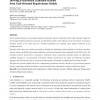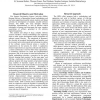CORR
2010
Springer
14 years 12 days ago
2010
Springer
Abstract. We present our approach for deploying and managing distributed component-based applications. A Desired State Description (DSD), written in a high-level declarative langua...
ASE
2008
14 years 13 days ago
2008
In the last years several efforts have been devoted by researchers in the Requirements Engineering community to the development of methodologies for supporting designers during req...
ASE
2008
14 years 13 days ago
2008
Goal-oriented methods are increasingly popular for elaborating software requirements. They offer systematic support for incrementally building intentional, structural, and operati...
ASWEC
2010
IEEE
14 years 16 days ago
2010
IEEE
—A quality-driven approach to software development and testing demands that, ultimately, the requirements of stakeholders be validated against the actual behavior of an implement...
ECMDAFA
2008
Springer
14 years 1 months ago
2008
Springer
In requirements engineering, there are several approaches for requirements modeling such as goal-oriented, aspect-driven, and system requirements modeling. In practice, companies o...
CIDR
2009
14 years 1 months ago
2009
: For the past year, we have been assembling requirements from a collection of scientific data base users from astronomy, particle physics, fusion, remote sensing, oceanography, an...
RIAO
2000
14 years 1 months ago
2000
Requirements engineering is the first stage in the software life-cycle and is concerned with discovering and managing a software system's services, constraints and goals. Req...
EHCI
1998
14 years 1 months ago
1998
: The EHCI'98 Workshop on Requirements of Groupware Development Tools examined six groupware applications in order to derive requirements for tools for developing groupware. W...
AAAI
2000
14 years 1 months ago
2000
or cone, abstraction is chosen to represent a spectrum of user inputs/requirements that are narrowed, refined, and structured into a system design. User inputs require refinement f...
SPLC
2004
14 years 1 months ago
2004
In this paper, we present a methodology to express, in a formal way, the requirements of products belonging to a product line. We relied on a formalism allowing the representation ...




